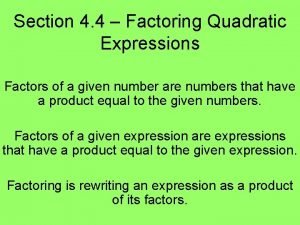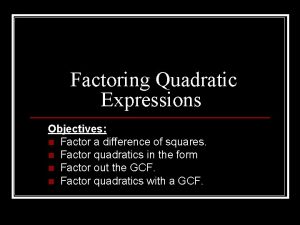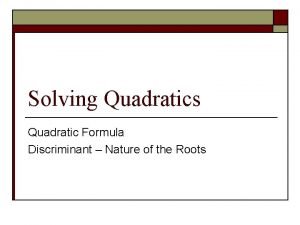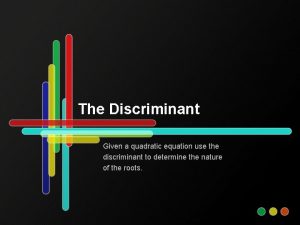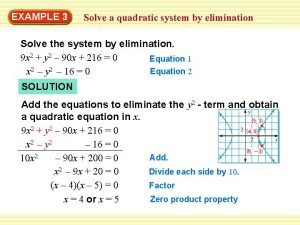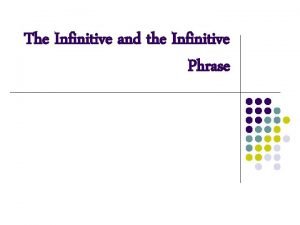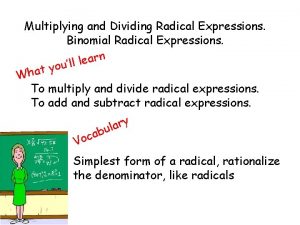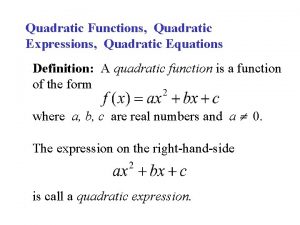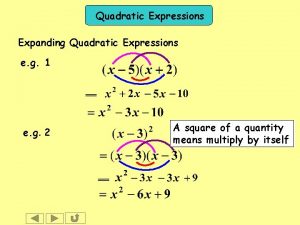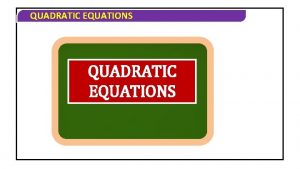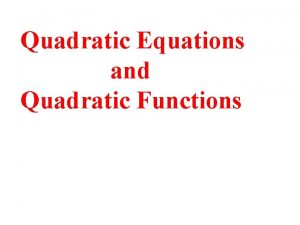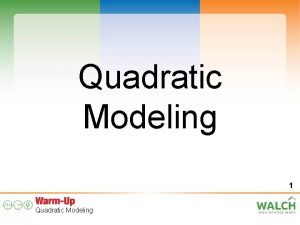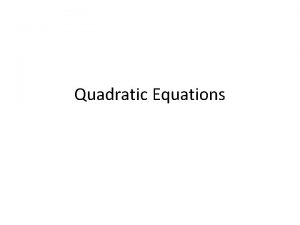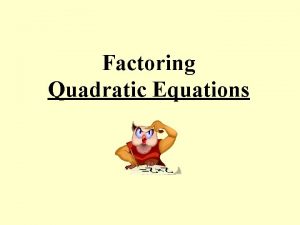Quadratic expressions A quadratic expression is an expression











- Slides: 11

Quadratic expressions A quadratic expression is an expression in which the highest power of the variable is 2. For example, 2 t x 2 – 2, w 2 + 3 w + 1, 4 – 5 g 2 , 2 The general form of a quadratic expression in x is: ax 2 + bx + c (where a = 0) x is a variable. a is a fixed number and is the coefficient of x 2. b is a fixed number and is the coefficient of x. c is a fixed number and is a constant term. 1 of 73 © Boardworks Ltd 2005

Factorizing expressions Remember: factorizing an expression is the opposite of expanding it. Expanding or multiplying out a 2 + 3 a + 2 (a + 1)(a + 2) Factorizing Often: When we expand an expression we remove the brackets. When we factorize an expression we write it with brackets. 2 of 73 © Boardworks Ltd 2005

Factorizing quadratic expressions Quadratic expressions of the form x 2 + bx + c can be factorized if they can be written using brackets as (x + d)(x + e) where d and e are integers. If we expand (x + d)(x + e) we have, (x + d)(x + e) = x 2 + dx + ex + de = x 2 + (d + e)x + de Comparing this to x 2 + bx + c we can see that: The sum of d and e must be equal to b, the coefficient of x. The product of d and e must be equal to c, the constant term. 3 of 73 © Boardworks Ltd 2005

Factorizing quadratic expressions 1 4 of 73 © Boardworks Ltd 2005

Matching quadratic expressions 1 5 of 73 © Boardworks Ltd 2005

Factorizing quadratic expressions Quadratic expressions of the form ax 2 + bx + c can be factorized if they can be written using brackets as (dx + e)(fx + g) where d, e, f and g are integers. If we expand (dx + e)(fx + g)we have, (dx + e)(fx + g)= dfx 2 + dgx + efx + eg = dfx 2 + (dg + ef)x + eg Comparing this to ax 2 + bx + c we can see that we must choose d, e, f and g such that: a = df, b = (dg + ef) c = eg 6 of 73 © Boardworks Ltd 2005

Factorizing quadratic expressions 2 7 of 73 © Boardworks Ltd 2005

Matching quadratic expressions 2 8 of 73 © Boardworks Ltd 2005

Factorizing the difference between two squares A quadratic expression in the form x 2 – a 2 is called the difference between two squares. The difference between two squares can be factorized as follows: x 2 – a 2 = (x + a)(x – a) For example, 9 x 2 – 16 = (3 x + 4)(3 x – 4) 25 a 2 – 1 = (5 a + 1)(5 a – 1) m 4 – 49 n 2 = (m 2 + 7 n)(m 2 – 7 n) 9 of 73 © Boardworks Ltd 2005

Factorizing the difference between two squares 10 of 73 © Boardworks Ltd 2005

Matching the difference between two squares 11 of 73 © Boardworks Ltd 2005
 Quadratic equation
Quadratic equation 4-4 factoring quadratic expressions
4-4 factoring quadratic expressions Factoring polynomials gcf and quadratic expressions
Factoring polynomials gcf and quadratic expressions Quadractic formual
Quadractic formual Find the discriminant of the quadratic expression
Find the discriminant of the quadratic expression Solving quadratic equations by elimination
Solving quadratic equations by elimination Translating algebraic expressions
Translating algebraic expressions Greetings farewells and special expressions
Greetings farewells and special expressions An infinitive phrase
An infinitive phrase Binomial radical expressions
Binomial radical expressions Fixed expressions cae
Fixed expressions cae Legal moves for simplifying and comparing expressions
Legal moves for simplifying and comparing expressions

